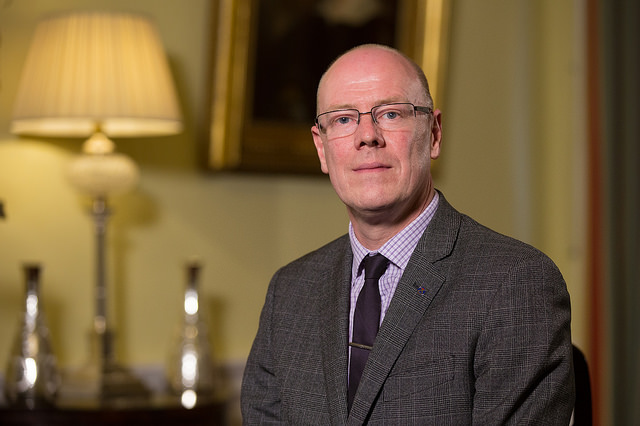Kevin Stewart MSP: What kind of Scotland do we want to see post-lockdown?
In the first in a series of blogs about how planning can respond to new and old challenges, planning minister Kevin Stewart offers some thoughts about recent events and what the future might bring for our places and people.

Kevin Stewart MSP
The impact of the coronavirus (COVID-19) crisis has made many of us reflect on the importance and the value of the places where we live, work, shop and socialise. Now as we begin to come out of lockdown, instead of just getting things back to the way they were before, we have a new opportunity to change our places and communities for the better.
Having spent the vast bulk of the lockdown period in a small flat in Edinburgh without its own garden space and with often busy public parks, I have longed to be back in Aberdeen to take advantage of the outdoor space that our garden provides. I have looked on with envy at the flats nearby that have balconies, which provide folk with a wee bit of outdoor space.
The need to shift to a new way of doing things was already pressing before COVID-19 hit, and the pandemic has not diminished the challenges we face – from climate change, housing need, town centres to health and socio-economic inequalities.
Sadly, as we have seen clearly in the last few months, pressure is not felt evenly across society, and those who are most vulnerable bear the brunt of the of stresses.
However it has been encouraging to see that in midst of hardship there has been commitment and ingenuity from communities.
In my own constituency, since March, 600 people and 40 businesses have supported Aberdeen Cyrenians to come together to help those most in need.
It is this kind of community-led action that we will need to help repair the damage done by the pandemic. From my own perspective as Planning Minister, I’m thinking about how I can support those efforts going forward. Digital planning, a focus on inclusive growth, strengthening community involvement, the fourth National Planning Framework (NPF4), and designing places that have people at their heart, can all support a recovery that also tackles the complex challenges we faced before.
The 2019 Planning Act made changes to strengthen public involvement in planning processes, and we are working quickly to offer alternatives to face to face engagement under current circumstances. We have already seen Aberdeenshire Council innovate to support digital engagement on its proposed plan. Even without face to face meetings, folk can still influence how they would like to see their communities shaped.
We are learning from these examples to develop our own accessible and hopefully even fun ways to engage digitally with NPF4, as well as traditional methods. Recent months have shown us just how important it is to make sure that everyone’s voice is heard.
The pandemic has raised fundamental questions about what we need from our places in the longer term. NPF4 was already in the pipeline, but now takes on new significance as an opportunity to support a green recovery.
So much time spent in and around our houses has emphasised the need for decent, well-designed, connected, energy efficient, affordable homes for all. Places where people feel safe, unconfined and relaxed.
Many of us who can work from home have grown used to the new arrangements, and are asking if we will ever go back to the regular commute to the office we were used to. Will community hubs provide a cornerstone for a new way of working? Underused buildings, high streets and town and village centres all present opportunities for a rethink of where and how we work.
The links between our environment and our health have been under the spotlight: air quality improvements brought about in very short measure as a result of significant reduction in vehicular travel, the mental health impacts of social isolation, the importance to physical and mental health of being able to access greenspace. How to we continue to capture the benefits of some of the changes as well as tackle some of the difficulties that have arisen?
And I have seen councils take quick action supporting businesses to adapt to our new circumstances; we have to ask if temporary uses for buildings and spaces is something we can be more creative with in the future. This is all in the context of big questions about what kind of recovery we want and need to see. There are implications for how much and what type of land we allocate for employment, and the importance of local networks has become even more apparent. I will watch with interest to see the outcomes of North Ayrshire Council’s innovative ‘Community Wealth Building’ approach. This could align well with emerging work on indicative regional strategies that will feed into NPF4.
Finally this experience has brought what we already knew into sharper focus: successful places are those that are built, first and foremost, around people. The progress we were already making on infrastructure for active travel has accelerated, with pop up changes on the ground in Aberdeen, Edinburgh and Glasgow that have made it easier for people to cycle to work, or enjoy their local greenspace. And the discussion about ‘reopening’ has to consider how we can reallocate space to allow people to meet their friends and families safely, and for businesses to be able to get back to work.
COVID-19 has shaken our society to its core. However, when we focus on creating places with people and for people, we will be better able to respond to a constantly evolving situation, and strengthen our future resilience.
Over the next few months my team and I will be sharing more thoughts on how we can respond, and we are keen to hear your ideas. Look out for future blogs, and please get in touch by emailing scotplan@gov.scot or on Twitter @ScotGovPlanning #scotplan.









